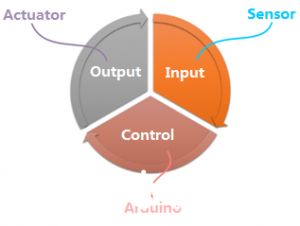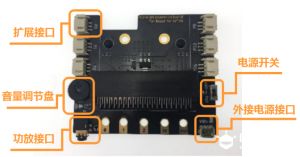“Introduction to Micro:bit Particle Creation” is a beginner’s tutorial combining micro:bit with BOSON, suitable for beginners who are new to micro:bit and programming. By following this tutorial, learners will start with a simple blinking LED project and gradually understand the principles of makecode programming and the workings of BOSON modules, ultimately achieving advanced features such as wireless communication and gesture recognition. This course includes 14 lessons of electronic textbooks and corresponding teaching video files. The course cases are engaging and relatable, making learning enjoyable.making learning enjoyable.
The course cases are engaging and relatable, making learning enjoyable. The Micro:bit Particle Creation Kit (Micro:bit for BOSON) is a set equipped with six basic BOSON sensor modules, colorful LED strips, and servo modules for graphical programming (makecode) with micro:bit. It allows for over 10 basic projects, helping students quickly recognize input and output modules, learn the input/output modes of electronic signals, understand the operational mechanisms of interactive devices, and master the usage and characteristics of various electronic components, sensors, and actuators. Additionally, it aids students in quickly grasping programming skills and applying them to practical projects.
Teaching Software: MakeCode Online Visual Programming Platform
Part Two: What Makes Our Machines ‘Alive’?
Interactive Devices
In the following chapters, we will build some interactive kit projects, starting from lighting up an LED to displaying cool rainbow LED strips and music settings. These kits can also be classified as “interactive devices”. To help you better understand their mechanical principles, we first need to clarify their structure.
The simplest interactive devices consist of three parts:
-
An input unit for command reception or data collection
-
A control unit for data processing or signal processing
-
An output unit for sending data or executing actions

So what do these units mean? Taking ourselves as an example, we collect information in forms of light, sound, taste, and touch through our eyes, ears, nose, and skin. This information enters our brain to decide what reaction to take. Ultimately, we act based on this information to change our physical environment. Specifically, for example, when your friend says “hello” to you, you respond with “hello”; your ears act as the input element, your brain as the control module, and your mouth as the output unit.
Similarly, for micro:bit projects, we use various sensors as input units, the micro:bit mainboard as the control unit, and actuators as output units.
Input Unit – Sensors
Sensors (also known as transducers) are physical components that can perceive or detect environmental characteristics (such as light, temperature, humidity, etc.) and convert them into signal data. In this tutorial, we will use buttons, sound sensors, and temperature sensors.
Control Unit – Micro:bit Mainboard
The Micro:bit mainboard will act as the control unit, establishing the connection between input and output units using signal pins, and processing data in the computing module.
Output Unit – Actuators
Actuators are devices responsible for moving or controlling a system or mechanical structure. They convert electrical energy into motion, sound, and light. In this tutorial, we will use actuators such as LED lights, small fans, and servos.
The Relationship Between Programs and Hardware
The input unit, control unit, and output unit mentioned above are all hardware. Analogous to humans, hardware is our body. However, the brain is more important because it generates thoughts and controls our every action. Here, the program is like our brain. For humans, both body and brain are indispensable.
Micro:bit Expansion Board
The Micro:bit expansion board can extend buttons and switches, expand power interfaces, and other module interfaces, allowing modules to be directly connected to the expansion board, making circuit connections faster and more efficient, and enhancing the capabilities of micro:bit.

Lesson 1 Review Part One: MakeCode and Micro:bit
——End of Text——
Recommended Reading:
Mushroom Cloud Maker Education “Partner Recruitment Conference” – Join Hands to Build China’s Innovation Power
Suzhou Science and Technology City Foreign Language School Talks About STEM Education, From Nurturing Curiosity to Stimulating the Desire to Learn
Heavyweight! The Offline Version of the Official Micro:bit Programming Software is Now Online!
Two Sessions Hot Topic丨What Did These Internet Giants Say About Maker Education at the Two Sessions?
Opportunities and Challenges for Maker Education Development Under Policy Support
High School New Curriculum Standards Interpretation 2: The Internet of Things Officially Enters Classroom Teaching, Mushroom Cloud Teaches You How to Open the Door to the Internet of Things in 10 Minutes!
Heavyweight! The New High School Curriculum Standards Released, Maker Education Content Has Become a Main Force in Technical Courses!
M
ushroom
Cloud
The Mushroom Cloud Maker Space, initiated by DFRobot in 2013, is recognized by the Ministry of Science and Technology as a National Maker Space.
As a sub-brand of DFRobot, it plays multiple service roles in the maker education ecosystem created by the company, including maker space solutions, teacher training, curriculum development, cultural dissemination, project guidance, and more.
Reply in the backend【mb】 to download Micro:bit Chinese Learning Materials
Reply【2018】 to download the complete content of the new curriculum standards
Reply【IoT】 to view the IoT learning module OBLOQ tutorial
Reply【Books】 to view recommended maker education textbooks

Long press the QR code to follow,
More exciting content continues to be updated!
↓↓↓ Click“Read the Original”, discover more surprises!